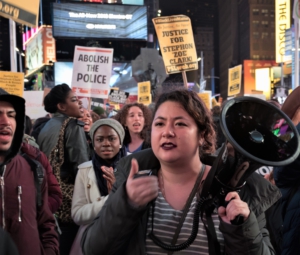
A thousand angry multinational demonstrators took to the streets in New York City on the evening of March 28 to show solidarity with the Sacramento community as they continue to protest the brutal murder of Stephon “Zoe” Clark by the Sacramento Police Department on March 18.
The officers, claiming that Clark was breaking car windows, pursued him and killed him in his own back yard. The officers immediately lied about the situation, claiming that Clark had a gun and lunged at them which provoked their use of deadly force. After no gun was found, and body cam footage confirmed that the police were fabricating events, the officers retracted their story.
Further contradicting the police story, a private autopsy findings released March 30 revealed that Clark had been hit a total of eight times, with six of those shots striking him in the back. Former San Joaquin County forensic pathologist Dr. Bennet Omalu, who performed the independent autopsy, said “During the entire interaction he had his back to the officers, not his front.”
Since the murder and the release of the helicopter video showing the execution of yet another African American at the hands of racist police, protests have erupted in several cities. Demonstrators in Sacramento shut down major traffic arteries, shut down a City Council hearing regarding the shooting, and even blocked entry into a Sacramento Kings basketball game.
Angry NYC protestors take the streets
The New York City march assembled at Columbus Circle and immediately took the streets, despite police warnings of arrest by loudspeaker if the demonstrators did so. The size of the crowd and the militancy of the youth eclipsed the crowd control tactics of the New York Police Department for a large part of the march. Bystanders applauded, drivers of cars and trucks honked their horns in support, as demonstrators chants of “No justice, no peace!” and “Justice for Stephon Clark!” could be heard from blocks away. At one point a woman went out on the fire escape of her walk-up apartment and began banging pots and pans.
The march swelled from about 600 to 1,000 as it went through the theater district and arrived at Times Square, the city’s largest tourist destination. The crowd was so large at one point that it became almost impossible to distinguish between protesters and bystanders. The march concluded at Father Duffy Square with demonstrators chanting and giving speeches. Robert Packnett, from the Party for Socialism and Liberation, closed out with Assata’s Prayer: “It is our duty to fight for our freedom! It is our duty to win! We must love and support each other! We have nothing to lose but our chains!”
Recall protests against police murder of Eric Garner
The march for Stephon Clark resembled to some extent the mass protests that took place here amid the non-indictment of NYPD Officer Daniel Panteleo, the cop who was seen on video strangling Eric Garner to death in 2014. The demonstrations that followed saw tens of thousands of people in the streets of this city, with demonstrators shutting down major traffic arteries and pressuring the mayor and chief of police to adjust their tactics as to not provoke a more protracted uprising.
Connecting police violence and vigilante violence
The police have so far killed over 250 people in 2018 alone. This prevalence of police murder comes at a time of increased popular pressure to end gun violence nationally. The fascistic murder spree at Stoneman Douglas High School in Parkland, FL, evoked national outrage, and a movement has grown calling for changes to the nation’s gun laws.
What is largely missing from mainstream discourse, however, is an analysis of how the violence waged domestically and internationally by the U.S. state apparatus is inextricably linked to homegrown vigilante violence. Discussion around gun violence in the U.S. must necessarily include a discussion about the role of the police in U.S. society. Their role is that of a protective shield used by the exploiting minority ruling this country against the exploited majority working class. This protection entails terrorizing oppressed nations and genders into submission to the capitalist social and economic order.
The leadership March for Our Lives movement, which has been endorsed heavily by the liberal Democratic establishment, has so far confined the issue of gun violence to simply being about individual vigilantism and “gun control.” Many in the Democratic Party seek to keep the focus narrow, to channel this movement into the 2018 elections.
Nonetheless, many in this new movement are open to making the connections between vigilante violence and the violence of the state. Many of the youth who were at the March for Our Lives in New York City also came to the demonstration for Stephon Clark. They carried anti-cop signs, chanted slogans, and were ready to be out in the streets.
Justice for Stephon Clark and all victims of police murder!
#NoJusticeNoPeace #JusticeForStephonClark #EndPoliceTerror






